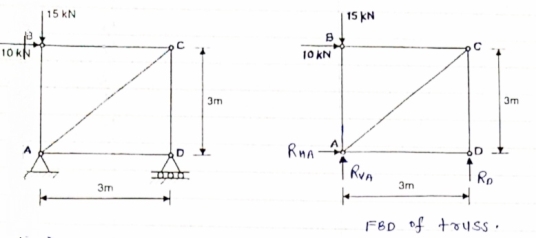|
Consider FBD of Truss, For equilibrium, RHA+100 =0 RHA =-100 KN
MA = 0 -------Taking moment @ A - (Roxz) + (100*1) + (100*1.732) =0 - - 2 Rd + 100 + 1.7320 =0 - -2 Rd + 100 + 173.2 =0 - RD =136.66 N () From eqn (1) RVA = 100 – 136.6 RVA= 36.6N RVA = 36.6 N Consider Joint D, for equilibrium, Fx =0 -FAD + FCD cos 60 =0 – (11) Fy = 0 136.6 +FCD sin 60 +0 FCD = -157.73 N © From eqn (11), Fad =- 78. 87 N (c) Consider point A, for the equilibrium of point A,
- 100 + FAD + FAc cos + 30 FAb cos60 = 0 -100 + (-78.87) +FAC cos 30 +FAb cos60 =0 FAc cos 30 + FAB cos60 + 178. 87 (3)
-36.6 + FAC sin 30 + FAB sin 60 =0 FAC sin 30 + FAb sin 60 = 36.6 Solving eqn (3) and (4) FAC = 273.21 N (T) FAB = -115.47 N FAB= 115.47 N © Consider point B, for the equilibrium of point,
-FAB cos60 + FBC =0 -[9-115.47) cos60]+ FBC =0
FBC = -57.73 N FBC =57.73N
|
|
Consider FBD of Truss, For the equilibrium of Truss, RHA + 10 =0 RHA = -10 KN RHA =10KN ( Resolving forces vertically,
RVA + RD -15 =0 RVA + RD = 15 …… (1) Taking moment about point A,
(10*3) – 3 Rd =0 30+ 3 Rd =0 RD= 10 KN RVA = 5KN ( Now Consider joint B, FBD of joint B is shown below. Assuming forces developed in all members to be Termile, For the equilibrium of joint We have
10+FBC =0 FBC = -10 KN FBC = 10KN (c)
FAB = -15 KN FAB = 15 KN (c)
Now consider joint c, For the equilibrium of joint,
-FBC – FAC cos 45 =0 - (-10) – FAC cos 45=0 10= FAC cos 45 FAC = 10/cos 45 FAc = 14.14 KN (T)
-Fac sin 45 – FCD=0 - 14.14 sin45 = FCD FCD = -10 KN (c) FCD= 10 KN (c)
Consider joint D, By observation, FAD=0
|
Truss
| Frame
|
Simple Band Brake: Friction can be used as a power-transmitting agent (in belts-pulleys) as well as a power-absorbing agent (in band brakes). The idea is, the band resists the motion of rotating wheel through friction. The braking torque is obtained by the relations
And
In this case, the values of |
Imperfect truss: A truss which does not collapse under the load is called Imperfect or unstable truss. Here n
Over stable (Redundant Truss) A truss in which n > 2j- R, Then it is over stable truss. Diagram
Deficient truss It is a truss in which N <2 j-R.
|
Cantilever Truss:
A truss which is fixed on one side & free of other end is called as cantilever truss. Diagram
|

































